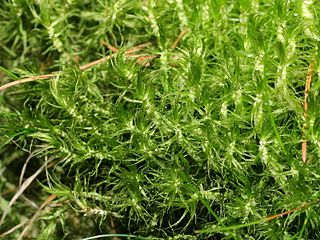
Funaria is a genus of approximately 210 species of moss. Funaria hygrometrica is the most common species. Funaria hygrometrica is called “cord moss” because of the twisted seta which is very hygroscopic and untwists when moist. The name is derived from the Latin word “funis”, meaning "a rope". In funaria root like structures called rhizoids are present.

Dicranum is a genus of mosses, also called wind-blown mosses or fork mosses. These mosses form in densely packed clumps. Stems may fork, but do not branch. In general, upright stems will be single but packed together. Dicranum is distributed globally. In North America these are commonly found in Jack pine or Red pine stands.

Porella is a large, common, and widespread genus of liverworts in order Porellales. It is a member of the family Porellaceae within that order.

Metzgeria is a genus of thalloid liverworts in the family Metzgeriaceae.
Molendoa is a genus of moss in family Pottiaceae.

Schistochila is a genus of liverworts in the order Jungermanniales. It is the only genus in the family Schistochilaceae.

Dicranaceae is a family of haplolepideous mosses (Dicranidae) in class Bryopsida. Species within this family are dioicous. Genera in this family include Dicranum, Dicranoloma, and Mitrobryum.

Grimmia is a genus of mosses (Bryophyta), originally named by Jakob Friedrich Ehrhart in honour of Johann Friedrich Carl Grimm, a physician and botanist from Gotha, Germany.

Tayloria is a genus of mosses in the family Splachnaceae. It comprises 45 species, divided among 6 subgenera:

Barbula is a genus of mosses in the family Pottiaceae.

Ditrichum is a genus of haplolepideous mosses (Dicranidae) in the family Ditrichaceae.

Schistidium is a plant genus in the moss family Grimmiaceae.

Thuidium is a genus of moss in the family Thuidiaceae. The name comes from the genus Thuja and the Latin suffix -idium, meaning diminutive. This is due to its resemblance to small cedar trees.

Philonotis is a genus of mosses belonging to the family Bartramiaceae.

Plagiothecium is a genus of moss belonging to the family Plagiotheciaceae. It has a cosmopolitan distribution.
Campylium is a genus of mosses belonging to the family Amblystegiaceae.

Bryoerythrophyllum is a genus of mosses belonging to the family Pottiaceae. It was first described by Pan Chieh Chen and has a cosmopolitan distribution.
Herzogiella is a genus of mosses belonging to the family Hypnaceae.















